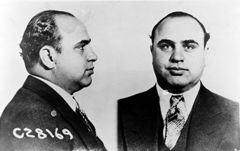A History of the Mug Shot
 Some of the very earliest photographs from the late 1830s are of alleged and/or convicted criminals, and law enforcement officials used photographs of criminals in Belgium as early as the 1840s to track down wrong-doers. In Paris, a clerk in the Prefecture of Police Office originated the “mug shot” as we usually imagine it — two shots side by side, with one shot being a frontal shot and the other being a profile.
Some of the very earliest photographs from the late 1830s are of alleged and/or convicted criminals, and law enforcement officials used photographs of criminals in Belgium as early as the 1840s to track down wrong-doers. In Paris, a clerk in the Prefecture of Police Office originated the “mug shot” as we usually imagine it — two shots side by side, with one shot being a frontal shot and the other being a profile.
This so-called “Bertillon System” was displayed at the Chicago World’s Fair in 1893, and it quickly caught on with American urban police departments. It was an age of science, and some thought of the mug shot as a useful component in “scientific law enforcement.” Indeed, there are surviving efforts by police departments to superimpose photographs of certain types of criminals on top of one another. We could then, theoretically, have distilled images of, to note only two of many possibilities, the typical pickpocket or typical forger.
In the present, mug shots are still with us, but we now live in an era in which the market rather than science is seen by many as our savior. It is possible to round up mug shots from public records and post them regardless of whether the pictured individuals have been prosecuted and/or convicted.

 You won’t find out from
You won’t find out from  I do intend to get back to my four-part series on whether Google’s collection of information from residential Wi-Fi networks violated the Wiretap Act. That issue is being litigated in the Northern District of California in a consolidated class action of home wireless network users, and the earlier posts in my series examined the plaintiffs’, Google’s, and the district court’s arguments on this issue. See
I do intend to get back to my four-part series on whether Google’s collection of information from residential Wi-Fi networks violated the Wiretap Act. That issue is being litigated in the Northern District of California in a consolidated class action of home wireless network users, and the earlier posts in my series examined the plaintiffs’, Google’s, and the district court’s arguments on this issue. See